
Transforming your garage with a fresh coat of paint can significantly enhance its appearance and functionality. Whether you’re looking to create a more organized workspace, add a splash of color, or simply freshen up the space, painting the walls is a practical and rewarding project.
With the right preparation and paint selection, you can turn your garage into a more inviting and versatile area that suits your needs and complements your home.
Garage Paint Walls

How to Paint Your Garage Walls
Transforming your garage with a fresh coat of paint can revitalize the space, making it more functional and visually appealing. Follow this guide to achieve a professional-looking finish.
Why Paint Your Garage Walls?
Enhancing Aesthetics
Painting your garage walls can significantly improve the overall look of the space. A fresh coat of paint can make the garage feel more inviting and clean.
Increasing Functionality
A well-painted garage can enhance organization and make it easier to maintain. Light colors can brighten the space, while durable finishes can protect the walls from stains and damage.
Adding Value
A newly painted garage can add value to your home. It shows that you’ve taken care of every aspect of your property, which can be appealing to potential buyers.
Preparation Steps
Cleaning the Walls
Start by cleaning the walls to remove dust, dirt, and any grease. Use a mild detergent and water, and let the walls dry completely before proceeding.
Repairing Damages
Inspect the walls for any cracks, holes, or imperfections. Use spackle or joint compound to fill these areas, and sand them smooth once they’re dry.
Choosing the Right Paint
Select a paint that is suitable for garage environments. Look for a high-quality, durable paint with good coverage and resistance to moisture and stains. Latex or acrylic paints are often recommended for garages.
Painting Process
Gathering Supplies
You’ll need paint, a roller, brushes, painter’s tape, drop cloths, and a paint tray. Ensure you have all these supplies ready before you start.
Applying Primer
For the best results, apply a coat of primer before painting. This helps the paint adhere better and provides a more even finish, especially if you’re making a drastic color change or painting over stains.
Painting the Walls
- Tape Off Areas: Use painter’s tape to cover any trim, windows, or areas you don’t want to paint.
- Cut In Edges: Using a brush, paint around the edges and corners where the roller won’t reach.
- Roll the Paint: Apply the paint with a roller in a “W” pattern to ensure even coverage. Overlap your strokes to avoid streaks and roller marks.
- Apply Additional Coats: Depending on the color and type of paint, you may need a second coat for full coverage. Allow the first coat to dry completely before applying the second coat.
Finishing Touches
Removing Painter’s Tape
Carefully remove the painter’s tape while the paint is still slightly wet to ensure clean lines.
Cleaning Up
Clean your brushes, rollers, and paint trays immediately after use. Dispose of any used materials according to local regulations.
Inspecting the Work
Once the paint is dry, inspect the walls for any missed spots or imperfections. Touch up as needed to achieve a smooth, even finish.
Tips for Success
- Ventilation: Ensure proper ventilation in the garage while painting to avoid inhaling fumes.
- Temperature: Paint in moderate temperatures for the best results. Extreme heat or cold can affect drying times and finish quality.
- Test Samples: Test a small area with the chosen paint color to ensure it looks as expected before committing to the entire project.
This structure will guide readers through the process of painting their garage walls, from preparation to finishing touches, with clear headings and subheadings for easy navigation.
What Type Of Paint Is Best For Garage Walls?
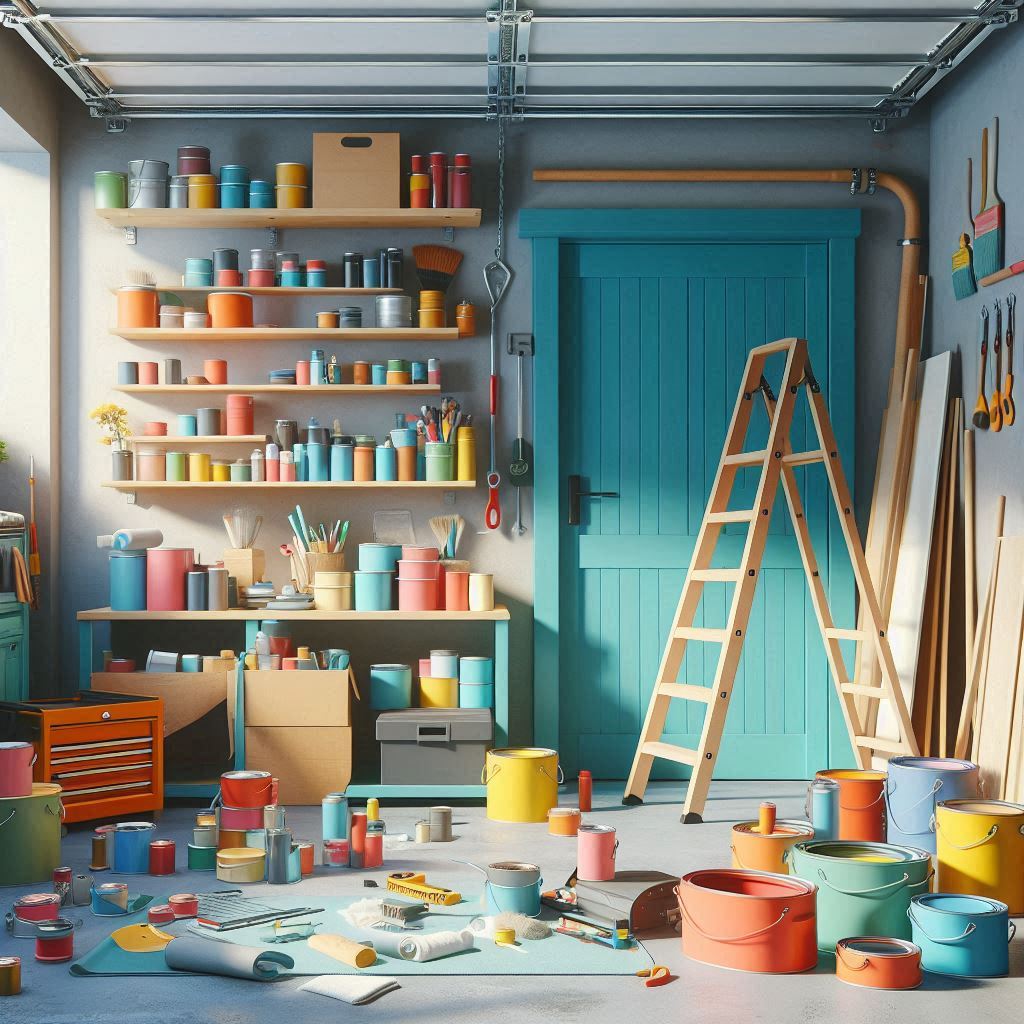
the best type of paint typically depends on the specific conditions and intended use of the space. Here are some recommendations:
1. Latex or Acrylic Paint
- Durability: Latex or acrylic paints are popular choices due to their durability and ease of application.
- Drying Time: They dry quickly and have low odor, making them suitable for indoor spaces.
- Cleaning: These paints are easy to clean with soap and water.
2. Epoxy Paint
- High Durability: Epoxy paint is highly durable and resistant to stains, chemicals, and moisture.
- Ideal for Heavy Use: It’s a good choice if your garage is used for heavy-duty tasks or if you need to protect the walls from frequent wear and tear.
- Finish: It provides a hard, glossy finish that is easy to clean.
3. Concrete or Masonry Paint
- Specialized for Concrete: If your garage walls are concrete or masonry, using paint specifically designed for these surfaces can enhance adhesion and longevity.
- Moisture Resistance: These paints often have properties to resist moisture and prevent mold growth.
4. Semi-Gloss or Satin Finish
- Easy Maintenance: A semi-gloss or satin finish is ideal for garage walls as it is easier to clean and maintain compared to flat finishes.
- Light Reflection: These finishes also help reflect light, making the garage appear brighter and more spacious.
What type of paint is best for garage walls?
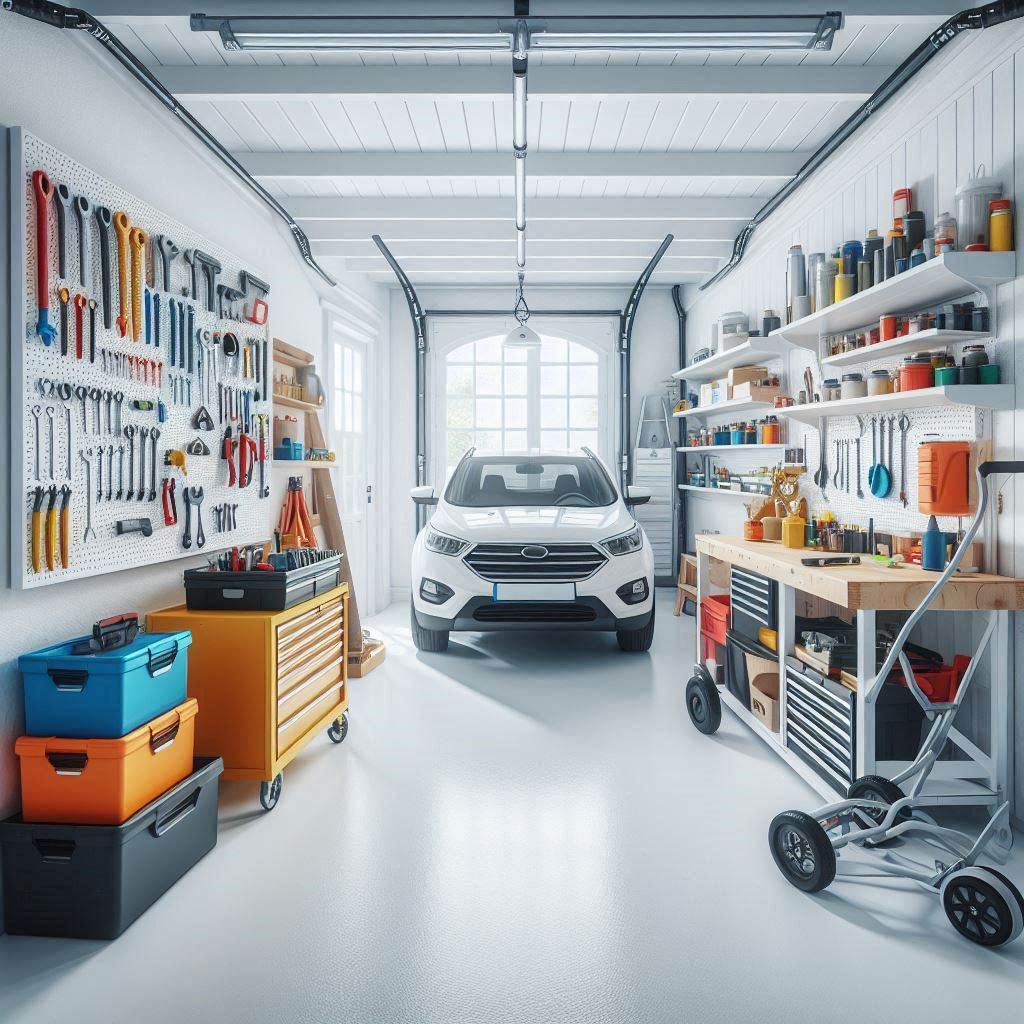
For garage walls, the best type of paint typically depends on the specific conditions and intended use of the space. Here are some recommendations:
1. Latex or Acrylic Paint
- Durability: Latex or acrylic paints are popular choices due to their durability and ease of application.
- Drying Time: They dry quickly and have low odor, making them suitable for indoor spaces.
- Cleaning: These paints are easy to clean with soap and water.
2. Epoxy Paint
- High Durability: Epoxy paint is highly durable and resistant to stains, chemicals, and moisture.
- Ideal for Heavy Use: It’s a good choice if your garage is used for heavy-duty tasks or if you need to protect the walls from frequent wear and tear.
- Finish: It provides a hard, glossy finish that is easy to clean.
3. Concrete or Masonry Paint
- Specialized for Concrete: If your garage walls are concrete or masonry, using paint specifically designed for these surfaces can enhance adhesion and longevity.
- Moisture Resistance: These paints often have properties to resist moisture and prevent mold growth.
4. Semi-Gloss or Satin Finish
- Easy Maintenance: A semi-gloss or satin finish is ideal for garage walls as it is easier to clean and maintain compared to flat finishes.
- Light Reflection: These finishes also help reflect light, making the garage appear brighter and more spacious.
Should garage walls be flat or eggshell paint?

For garage walls, a semi-gloss or satin finish is generally recommended over flat or eggshell paint. Here’s why:
Why Not Flat Paint?
- Durability: Flat paint is less durable and more prone to scuffs and stains. It doesn’t stand up well to the wear and tear often seen in garages.
- Cleaning: It’s harder to clean flat paint, which can be problematic in a garage environment where walls may get dirty or stained.
Why Semi-Gloss or Satin Paint?
- Ease of Cleaning: Semi-gloss and satin finishes are more resistant to stains and are easier to wipe clean, making them ideal for garages.
- Durability: These finishes are more durable and can handle the occasional bump, scrape, or dirt more effectively than flat paint.
- Light Reflection: They reflect more light, which helps brighten the space and make it look more open.
What Is The Cheapest Way To Finish A Garage Wall?
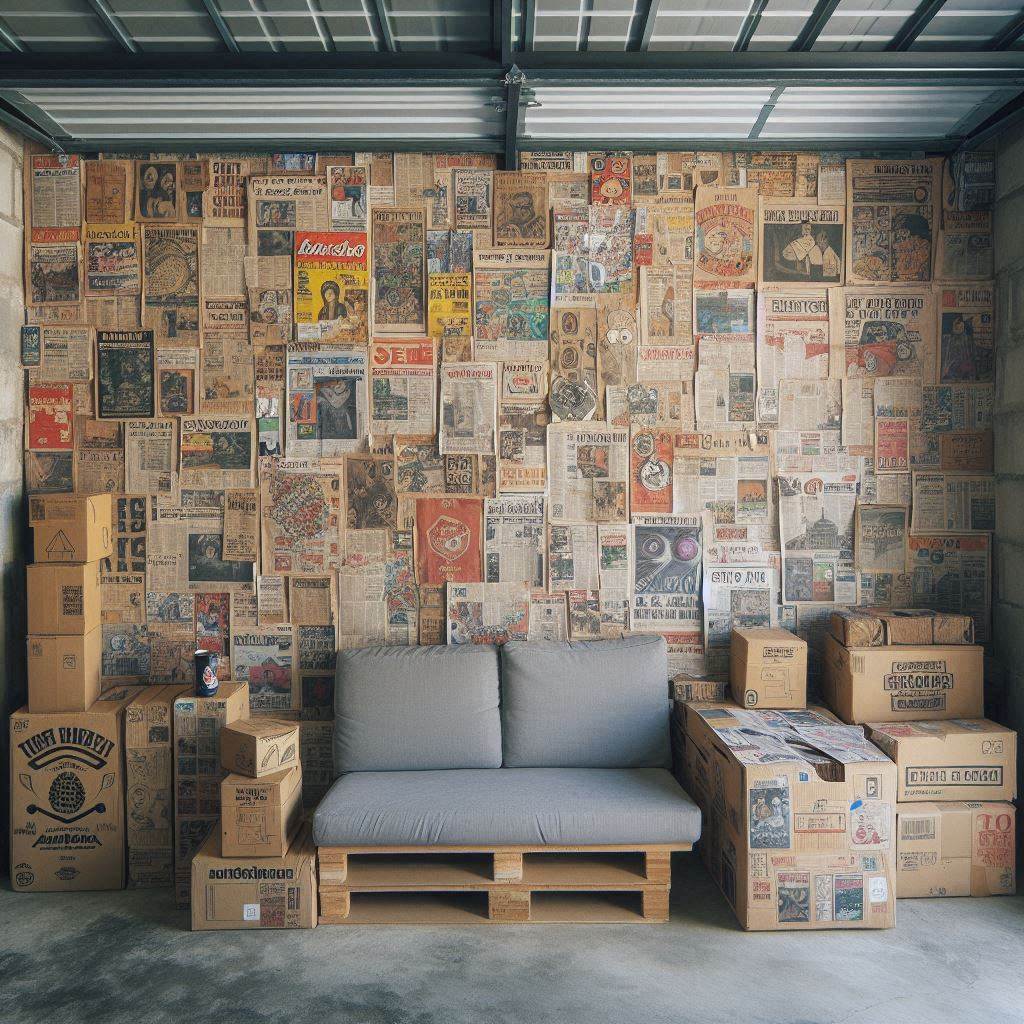
The cheapest way to finish a garage wall generally involves using basic, budget-friendly materials and methods. Here are some cost-effective options:
1. Basic Latex Paint
- Affordable: Latex paint is generally inexpensive and readily available at most hardware stores.
- Application: Apply a coat of primer if needed, followed by one or two coats of latex paint. This is a cost-effective way to achieve a clean look.
2. Pre-Primed Drywall Panels
- Economical: Pre-primed drywall panels can be a budget-friendly option for finishing garage walls. They come ready to paint, reducing prep work.
- Installation: Install the panels and then apply a single coat of paint for a simple, finished look.
3. Paneling
- Cost-Effective: Wooden or MDF paneling can be a cheaper alternative to drywall. It’s relatively easy to install and requires minimal finishing.
- Painting or Staining: You can paint or stain the paneling to achieve the desired look.
4. Concrete Sealer
- For Concrete Walls: If you have bare concrete walls, a concrete sealer is an economical way to finish them. It protects the surface and can improve the appearance without extensive preparation.
- Application: Apply a concrete sealer directly to clean, dry walls.
5. Plywood
- Budget-Friendly: Plywood can be a low-cost option for covering garage walls. It’s durable and can be painted or stained.
- Installation: Install plywood sheets directly onto the wall studs or existing surface, then paint or finish as desired.
Garage Paint Ideas: Solid Colors Only!
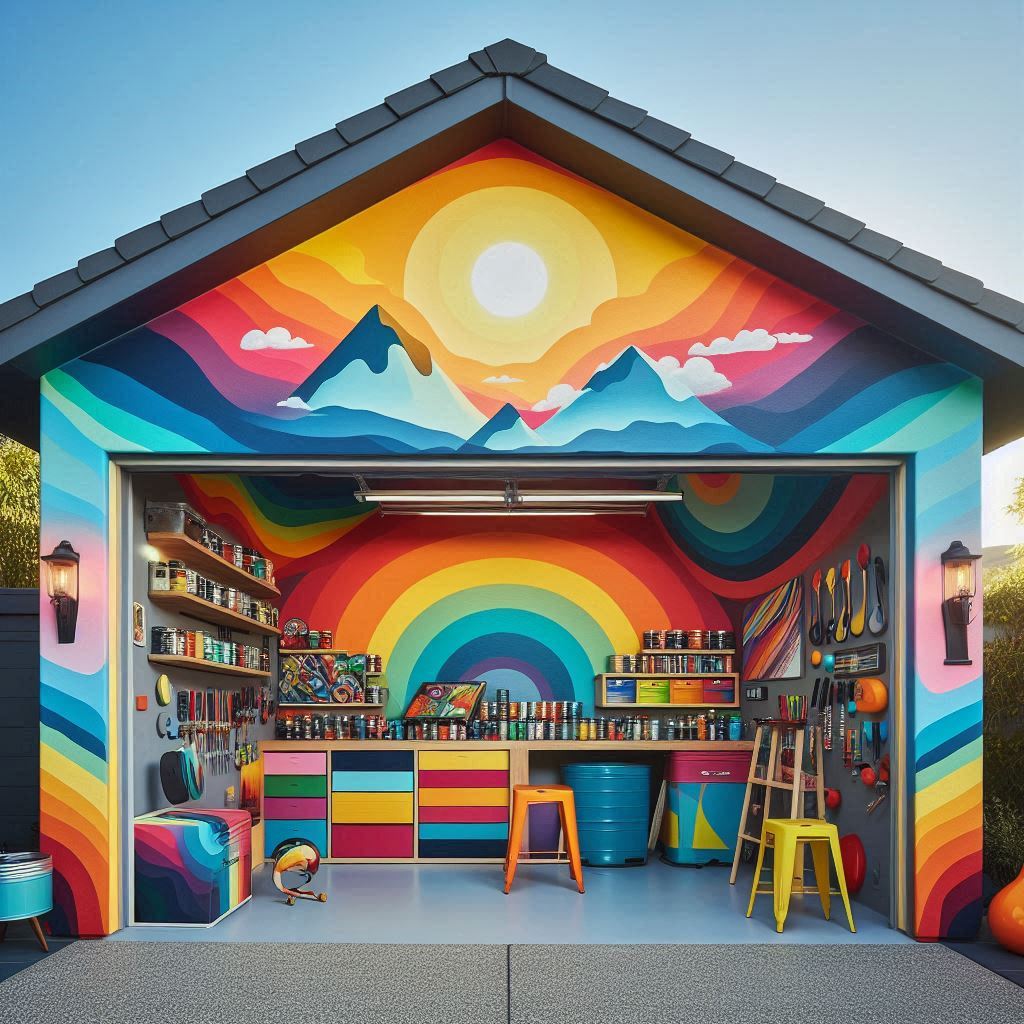
Here are some garage paint ideas using solid colors that can give your space a fresh and clean look:
1. Classic White
- Brightens the Space: White paint reflects light, making the garage appear larger and brighter.
- Versatile: Complements any style of decor and makes it easier to see dirt or stains, which helps in maintaining cleanliness.
2. Soft Gray
- Modern and Clean: Gray offers a sleek, modern look while hiding dust and stains better than white.
- Neutral Background: Provides a neutral backdrop that works well with various storage solutions and equipment.
3. Light Blue
- Calming Effect: Light blue adds a calming and refreshing touch to the garage.
- Good Light Reflector: Enhances natural and artificial light, making the space feel more open.
4. Sage Green
- Subtle and Elegant: Sage green adds a touch of sophistication without being too bold.
- Hides Marks: Good at concealing minor marks and dirt.
5. Charcoal Gray
- Stylish and Durable: Charcoal gray provides a sleek, modern look and is good at hiding stains and scuffs.
- Low Maintenance: Less frequent cleaning compared to lighter colors.
6. Beige or Taupe
- Warm and Neutral: These colors offer a warm, neutral tone that can make the garage feel more inviting.
- Practical: Hides dirt and minor imperfections effectively.
7. Navy Blue
- Bold and Dramatic: Navy blue adds a rich, deep color that makes a strong statement.
- Stain Concealing: Good at hiding marks and grime.
8. Olive Green
- Earthy and Practical: Olive green provides an earthy tone that complements various garage items.
- Camouflages Dirt: Helps conceal stains and dust.
Tips for Choosing and Applying Solid Colors
- Consider Lighting: Choose colors that work well with the lighting in your garage to ensure the space feels bright and open.
- Test Samples: Apply paint samples on a small wall section to see how the color looks in different lighting conditions.
- High-Quality Paint: Use a high-quality, durable paint to ensure a long-lasting finish, especially in high-traffic areas.
Solid colors can provide a clean and appealing finish to your garage while offering practical benefits such as ease of maintenance and versatility.
What Color To Paint Garage Ceiling?
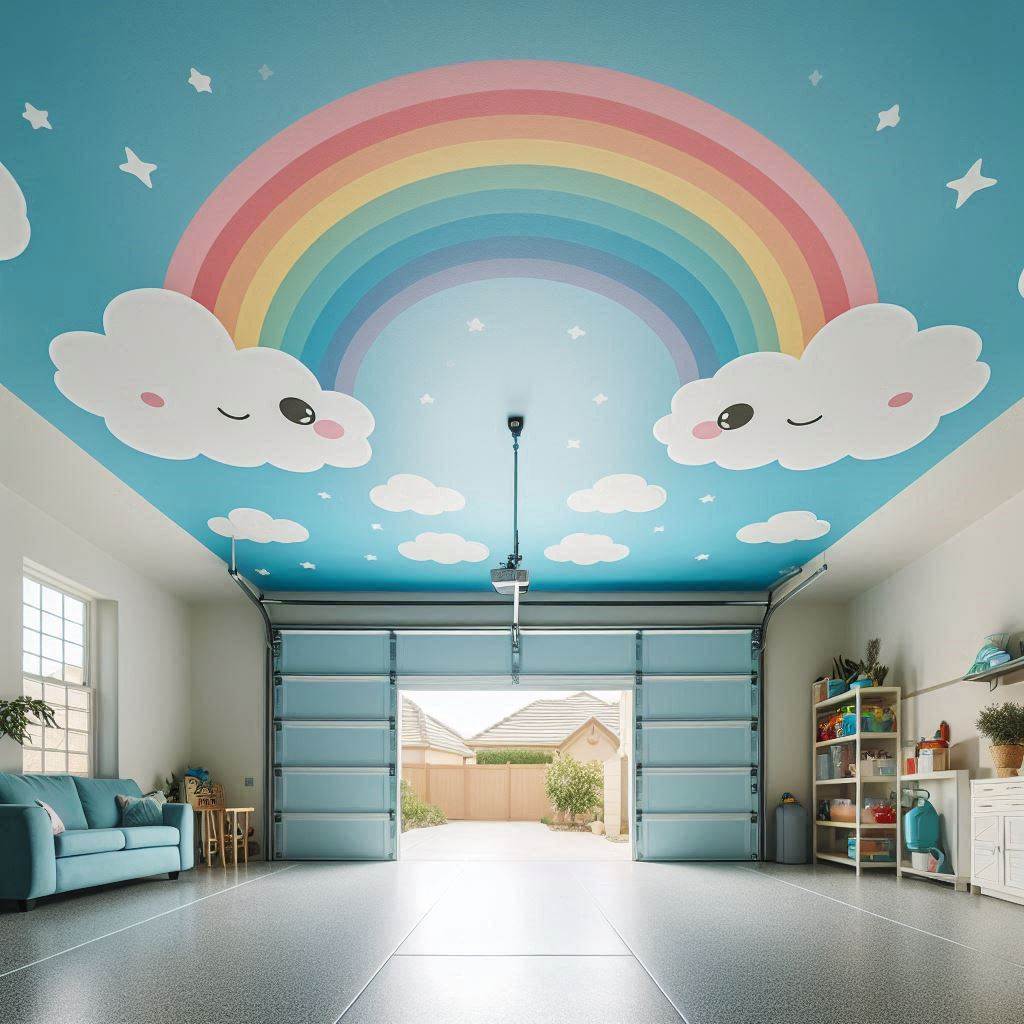
Choosing the right color for a garage ceiling can enhance the overall look and functionality of the space. Here are some color options and considerations:
1. Classic White
- Bright and Reflective: White is a popular choice as it reflects light well, making the garage appear brighter and more spacious.
- Easy to Maintain: It’s easy to spot dirt or cobwebs against a white ceiling, so you can keep the space clean more easily.
2. Light Gray
- Modern and Subtle: Light gray provides a modern look while still reflecting light well, similar to white but with a slightly softer tone.
- Hides Stains: It can be a practical choice for hiding minor stains and dust.
3. Soft Blue
- Calming and Fresh: A soft blue ceiling can create a calming effect and make the garage feel more open and airy.
- Light Reflection: Light blue reflects light effectively, enhancing visibility in the space.
4. Beige or Off-White
- Warm and Neutral: Beige or off-white ceilings add warmth without being too stark, providing a cozy and inviting feel.
- Conceals Dust: These colors can help conceal dust and minor imperfections better than pure white.
5. Light Green
- Refreshing and Unique: A light green ceiling can offer a refreshing and unique touch to the garage.
- Maintains Light: It reflects light well and creates a pleasant atmosphere.
Considerations
- Lighting: Choose a color that complements the lighting in your garage. Lighter colors tend to enhance natural and artificial light, making the space feel more open.
- Purpose: If the garage is used for detailed work or hobbies, brighter colors might help improve visibility.
- Aesthetics: Consider how the ceiling color will match with the walls and overall design of the garage.
Conclusion
Painting your garage walls is a practical and cost-effective way to enhance the space, making it look cleaner, more organized, and inviting. By selecting the right type of paint and color, and following the proper preparation and application steps, you can achieve a professional-looking finish that suits your needs and style.
Whether you opt for a classic white, a calming light blue, or a modern gray, the right choice will improve the functionality and aesthetic of your garage, transforming it into a more enjoyable and usable space.
FAQs
1. What type of paint is best for garage walls?
The best type of paint for garage walls is usually a high-quality latex or acrylic paint with a semi-gloss or satin finish. These options are durable, easy to clean, and resistant to stains and moisture. For added durability in high-use areas, consider epoxy paint or concrete/masonry paint if applicable.
2. How do I prepare my garage walls for painting?
Start by cleaning the walls to remove dust and dirt. Repair any cracks or holes with spackle or joint compound and sand them smooth. If necessary, apply a coat of primer before painting to improve adhesion and ensure an even finish.
3. Can I use flat paint for garage walls?
While flat paint is less reflective and may show dirt and stains more easily, it can be used if you prefer a matte finish. However, a semi-gloss or satin finish is generally recommended for garages due to its durability and ease of cleaning.
4. What color should I choose for my garage walls?
For garage walls, choose colors that enhance lighting and complement your personal style. Classic options include white, light gray, or soft blue, which brighten the space and make it feel larger. Consider darker shades like charcoal gray for a modern look that hides stains better.
5. How many coats of paint do I need?
Typically, two coats of paint are recommended for full coverage and a uniform finish. The first coat provides the base color and coverage, while the second coat ensures an even and complete finish. Allow the first coat to dry thoroughly before applying the second.
